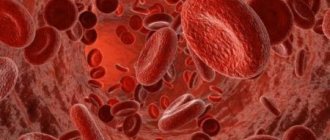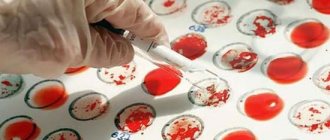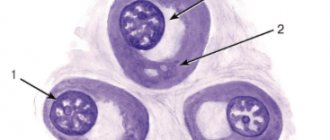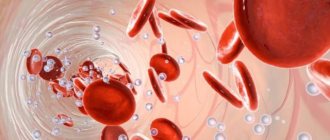As we all know, our blood consists of three very important components. Leukocytes, platelets and erythrocytes. Leukocytes - maintain our immunity normally, protecting us from pathogenic bacteria and microbes that penetrate our body, platelets - are responsible for blood clotting, protecting us from categorical blood loss, and red blood cells, which are called "Erythrocytes", in their In turn, they also perform quite important functions, they transport oxygen throughout the body, and they also contain a substance vital for humans - hemoglobin.
Thanks to the function of red blood cells, the blood functions normally and our organs are enriched with oxygen.
Normal indicators in a child
There is a formula that allows you to calculate the color index (hereinafter - CP): Indicator = (Hb x 3) / initial 3 digits Er (the comma is ignored), in which:
- Hb value – hemoglobin concentration;
- Er value – number of red blood cells.
Hemoglobin levels below normal cannot be ignored, because the organs of the human body are in a situation of oxygen starvation, which is especially dangerous for the brain. Cells, not receiving a proper “breath of air,” simply die. The table shows the norm of CP, red blood cells and hemoglobin according to the child’s age:
| AGE | ||||||
| newborn | 1 month | 6 months | 1 year | 16 years | 7 – 12 years | |
| Hemoglobin (Hb), g/l | 180 – 240 | 115 – 175 | 110 – 140 | 110 – 135 | 110 – 140 | 110 – 145 |
| Red blood cells (RBC),*1012 cells/l | 4,3 – 7,6 | 3,8 – 5,6 | 3,5 – 4,8 | 3,6 – 4,9 | 3,5 – 4,5 | 3,5 – 4,7 |
| Color index (MCHC), % | 0,85 – 1,15 | 0,85 – 1,15 | 0,85 – 1,15 | 0,85 – 1,15 | 0,8 – 1,1 | 0,8 – 1,1 |
What is a blood color index and why do you need to determine it?
The blood color index, or CP, shows the hemoglobin content - HGB (Hb, hemoglobin) in the red blood cell and serves to determine the type of anemia according to classification criteria. To calculate the degree of saturation of an erythrocyte with hemoglobin, 2 initial values are needed:
- number of red blood cells (million/μl);
- hemoglobin content (g/l).
CP is calculated by calculating the formula: hemoglobin mass is multiplied by 3 and divided by the first 3 digits of the number of red blood cells. For example, the value of Hb (hemoglobin) is 121 g/l, and RBC in the blood is 4.2 million/μR, the calculation will look like this: (121*3): 420 = 0.864, round up and get the value of 0.86.
What does a drop in CPU level indicate?
Anemia is one of the most famous diseases. In the modern world, more than a billion people suffer from it. Its outcome can be fatal if the disease was not detected in time or was left without proper attention. The cause of death is iron deficiency in the human body.
There is another type of anemia. This is iron redistribution - a process in which excess iron occurs in the blood, as red blood cells are destroyed ahead of schedule. This disease usually occurs with infectious organ damage. Iron-rich hypochromia should be distinguished because this condition occurs when the body contains the necessary supply of iron, but the bone marrow does not absorb it well. Occurs during drug intoxication and chemical poisoning. These types of diseases require different treatment.
This condition in newborns and children under one year of age is provoked not only by a lack of the necessary element in the mother, but also by difficult gestation of the fetus. Also at risk are children who are fed not breast milk, but various formulas and ready-made dairy products.
Pediatricians quite often encounter the development of anemic syndrome, because a child’s need for iron is much higher than that of adults. This is due to the fact that the body is in the stage of active growth for up to three years and spends a large amount of iron daily, and the person himself does not have time to replenish reserves with food. A long-term state of iron deficiency can lead to complications:
- respiratory tract infections;
- gastrointestinal diseases;
- neuropsychic disorders;
- decreased vision and hearing.
Symptoms of falling CPU levels are common to children of all ages. The child sweats excessively, is lethargic, and is capricious. There is a decrease in appetite, after feeding there is vomiting and regurgitation. Poor sleep, muscles become flabby, pale skin, tinnitus, frequent headaches, shortness of breath. Up to a year there may be regression of motor skills. Low CV can also occur in patients:
- with malignant neoplasms;
- in a state of microcytosis, which is provoked by reasons, the main of which is lead poisoning;
- tuberculosis;
- purulent infection;
- Thalassemia.
What to do?
Treatment for the decline of cirrhosis is based on four main principles: proper nutrition and eating habits, finding out the cause of low hemoglobin, prescribing medications, and therapy. The basis of treatment for infants is mother's milk. Mothers should adjust their diet, because iron enters the body and is well absorbed only during lactation.
If the level of hemoglobin in the blood is low, it is necessary to include in the diet foods containing large amounts of iron: halva, dried mushrooms, meat, seafood, beets, pomegranate (with caution if there are liver problems), legumes. It is good to supplement your diet with ascorbic acid. You should not neglect walks in the fresh air, but it is better to avoid stressful situations and physical activity.
Medicines are prescribed by a doctor individually, because negative reactions of the body are possible. Popular and effective medications that are usually prescribed for low hemoglobin levels include Maltofer, Ferlatum, and Antiferrin. Blood transfusions are also practiced, both total and red blood cell mass only. Physiotherapy and proven folk recipes are prescribed.
Norm of analysis in a child
The norm for a child (up to 3 years old) does not differ from the norm for an adult, and fluctuates around 0.8-1.1 . In a child under 3 years old, the norm is about 0.75-0.96 fluctuations .
A situation in which color analysis is reduced is considered to be a fairly common occurrence, and it also occurs in children. A reduced amount of hemoglobin in red blood cells is called hypochromia . This may be accompanied by oxygen deficiency, and there is also a suspicion of the development of anemia (anemia), in which the amount of hemoglobin in red blood cells decreases several times, which contributes to a lack of oxygen in the body, and is accompanied by symptoms such as: pallor, frequent headaches, drowsiness, fatigue, dizziness, brittle nails, insomnia, etc. In particular, anemia appears more often in women than in men.
The disease itself occurs both independently, for example, with a lack of vitamin B12, iron deficiency, excessive bleeding, disruptions in the formation of red blood cells, disorders in the germ cells, and against the background of any other diseases that are only catalysts for this disease. Ultimately, a low level of hemoglobin in red blood cells is a sign of a serious problem that should be addressed immediately.
General blood test - decoding of indicators
Home page » News » General blood test - deciphering the indicators
General blood test - decoding of indicators
Blood is the most important matter of the body, performing regulatory, nutritional, excretory, respiratory and other functions.
50% of blood consists of plasma. This is a multicomponent liquid that includes trace elements, enzymes and hormones. The other 50% belongs to blood cells, each of which has its own unique role.
Any disease, be it inflammatory, oncological, autoimmune or metabolic, affects the qualitative and quantitative composition of the blood. And therefore, the diagnosis of diseases begins with the appointment of a general blood test.
Definition and Purposes of Purpose
CBC (complete blood count) is a laboratory diagnostic method for assessing the condition of the body and searching for the source of pathology. This test can be prescribed by a doctor of any specialty. In what cases is OAC prescribed:
- For prevention during medical examinations. The composition of the blood is relatively constant and rarely goes beyond the normal range in a healthy person. And some diseases may not affect your well-being for a long time, and then a preventive test will become a reason for subsequent examination.
- When the first symptoms of illness appear. Analysis in this case can make it possible to determine the nature of the disease, the degree of intensity of inflammation or an allergic reaction.
- OAC may be re-prescribed to monitor the course of the disease over time. Also to assess the effectiveness of the therapy.
Prevention and prognosis
In order to prevent fluctuations in the central nervous system, parents need to strictly monitor the implementation of several simple general preventive recommendations, among which it is worth highlighting:
- healthy and nutritious nutrition;
- preventing the penetration of chemical or toxic substances into the child’s body;
- refusal to take medications for no apparent reason;
- frequent exposure to fresh air;
- avoiding physical and emotional exhaustion;
- Regular visits to the pediatrician and, if necessary, to other pediatric specialists.
In itself, fluctuations in the CPC do not in any way threaten the lives of children. However, complete refusal of medical care by parents increases the likelihood of the child developing complications and consequences of the underlying disease, which can be fraught with an unfavorable prognosis.
source
What indicators are included in the UAC?
The general blood test includes the following indicators: red blood cells, hemoglobin, leukocytes, color index, hematocrit, reticulocytes, platelets, ESR.
The leukocyte formula in some laboratories is signed by default, in some a doctor’s note is required. It includes the following indicators: eosinophils, basophils, band and segmented neutrophils, lymphocytes, monocytes.
Below is a table of norms for a general blood test:
| Index | Laboratory designation | Norma (women) | Norma (men) | Unit |
| Red blood cells | R.B.C. | 3,8-4,5 | 4,4-5,0 | 10 12 /l |
| Hemoglobin | HGB | 120-140 | 130-160 | g/l |
| Leukocytes | WBC | 4,0-9,0 | 4,0-9,0 | 10 9 /l |
| Color index | CPU | 0,8-1,0 | 0,8-1,0 | |
| Hematocrit | HCT | 35-45 | 39-49 | % |
| Reticulocytes | RET | 0,2-1,2 | 0,2-1,2 | % |
| Platelets | PLT | 170,0-320,0 | 180,0-320,0 | 10 9 /l |
| ESR | ESR | 2-15 | 1-10 | mm/hour |
| Leukocyte formula: | ||||
| Basophils | BAS | 0-1 | 0-1 | % |
| Eosinophils | EO | 0,5-5 | 0,5-5 | % |
| Myelocytes | % | |||
| Metamyelocytes | % | |||
| Band neutrophils | NEUT | 1-6 | 1-6 | % |
| Segmented neutrophils | NEUT | 47-67 | 47-67 | % |
| Lymphocytes | LYM | 18-40 | 18-40 | % |
| Monocytes | MON | 3-11 | 3-11 | % |
At some points, the standard blood test for adults differs from that for children.
For example, the norm of hemoglobin in a child is 110-145 g/l, leukocytes 5.0-12.0 10 9 / l, the content of lymphocytes can be in the range of 26-60%. The remaining blood test parameters correspond to the reference values for adults.
By order of the Ministry of Health, in the first year of life, a child’s blood is taken for general analysis 4 times, then at 1 year 6 months, and then annually, starting from two years. Such measures are necessary for the early detection of blood diseases, anemia, and infections.
Interpretation of a general blood test
Below are the most basic indicators of the KBC, their functions in the body, and the reasons for deviations upward or downward.
Red blood cells
These are small elastic cells containing hemoglobin in their cytoplasm. Due to their elasticity, they easily pass through vessels of any caliber. They are produced in the bone marrow, the viability of one cell is about 3-4 months.
Red blood cells perform the following function: they carry oxygen from the lungs to all human tissues and organs, and on the way back from the tissues to the lungs they bring carbon dioxide. All this happens by adding gases to the hemoglobin of the red blood cell.
The norm of erythrocytes when deciphering tests is on average from 3.8 to 5.0 10 12 / l
- An increase in red blood cells in a general blood test is possible with dehydration due to vomiting and diarrhea, diseases of the blood system (erythremia, Vaquez disease), cardiac and respiratory failure.
- their reduction can occur with blood loss, leukemia and lymphomas, congenital hematopoietic defects, hemolytic anemia, oncology, insufficient intake of protein, iron and vitamins.
It should be remembered that the norm of red blood cells, as well as other indicators, may differ in different laboratories. In which, moreover, errors are not excluded. Therefore, a borderline result does not always indicate a serious illness.
Hemoglobin
Hemoglobin is an iron-containing protein found in red blood cells. It is due to this that the function of gas exchange between the lung tissue and all cells of the body is performed. A deviation in hemoglobin levels from the norm can cause a person to feel unwell, weak, and easily fatigued. This is due to a lack of oxygen in organs, including the brain.
The normal hemoglobin content in a general blood test is on average 120-160 g/l, depending on the gender and age of the subject.
- An increase in hemoglobin can occur due to dehydration due to diabetes mellitus, vomiting and diarrhea, due to heart failure, overdose of diuretics, pulmonary failure, heart defects, diseases of the blood and urinary system.
- A decrease in hemoglobin in a general blood test is possible with anemia of various origins and other blood diseases, blood loss, insufficient intake of protein, vitamins, and iron
Leukocytes
These are white blood cells synthesized in the bone marrow. They perform the most important defense function in the body, aimed at foreign objects, infections, and foreign protein molecules. They are also able to dissolve damaged body tissue, which is one of the stages of inflammation. The viability of these cells varies from several hours to several years.
Norm and reasons for deviation
The color indicator carries very important information regarding the ratio of one of the main components of the main biological fluid of the human body - red blood cells and hemoglobin.
This value is a calculated value, and the units of measurement are percentages. The CPC norm depends on the age category of the child; gender is not taken into account.
It is important to know that if this parameter is reduced, clinicians speak of hypochromia, and if it is increased, of hyperchromia. It is noteworthy that each disorder is a pathological condition that has its own causes and requires treatment.
When a child’s blood color index is low, this may indicate the following pathologies:
- diseases of the hematopoietic system, among which it is worth highlighting thalassemia;
- hemoglobinopathy;
- renal failure;
- intoxication with chemicals, in particular lead;
- anemia of hypochromic or microcytic form.
Poor nutrition - insufficient intake of iron and vitamins from food - can affect the disorder.
When the value increases in children, this indicates that the child is suffering from the following conditions:
- oncopathology;
- diabetes;
- chronic hypoxia;
- diseases of the endocrine system - this includes hypothyroidism;
- hepatitis, cirrhosis or other liver damage;
- heavy blood loss;
- hemolytic or B12-deficiency anemia;
- heart or lung disease.
Often, a provocateur is the inadequate use of medications - parents often give their children medications for no apparent reason or do not follow the simplest recommendations for use (daily dose and duration of use).
Calculation of color index for children
Usually the color indicator is noted by the laboratory assistant on the blood test form, but you can calculate it yourself. To do this, you need to know:
- Red blood cell count (RBC)
- Hemoglobin level (H)
To calculate, multiply G by 3 and divide by the first three digits of the SE (the comma is not taken into account). For example, a child’s red blood cells are 4x10 12 /l, and hemoglobin is 120 g/l. Then to calculate the CPU you need (120x3):400, and as a result we get 0.9.
If a figure is obtained with a large number of decimal places, it is rounded to the nearest hundredth. For example, with a red blood cell count of 3.3 x 10 12 / l and a hemoglobin level of 95 g / l, we need (95 x 3): 330. The result will be 0.8636, that is, after rounding it will be 0.86.
An analogue of this indicator in a modern blood test is the erythrocyte index MCHC (this is how the average concentration of hemoglobin in red blood cells is designated). The parameter is needed to diagnose anemia, in particular to determine its cause and degree.
What is blood color index?
The color index of blood is the degree of enrichment of red blood cells (erythrocytes), an essential substance containing Fe (iron) and carrying hemoglobin. The main function of the test is that it provides information about the extent of measuring the number of red blood cells and hemoglobin in our body. The color indicator is detected during a general blood test.
What is normal CP in children?
The normal value of CP is influenced by the age of the child. In newly born babies, this indicator is higher, which is associated with the presence of cells with fetal hemoglobin in the bloodstream. However, by the month the color index decreases, and at the age of over a year it becomes less than one. Normal CP is also called "normochromia".
The color standard for children of different ages is:
Ages 1-5
Ages 5-10
At the age of 10-15 years
Reasons for low CPU
If a child's color index is low, this is called hypochromia. It is often diagnosed when the formation of red blood cells and their filling with hemoglobin is impaired due to iron deficiency. In this case, normal-sized red blood cells may not have enough hemoglobin, or the red blood cells themselves may be smaller in size (they are called microcytes).
If the parameter is determined below normal in a baby, this is due to anemia in the expectant mother during the gestation period or to poor nutrition of the nursing mother. In older children, anemia is most often provoked by an unbalanced diet, for example, if the child eats irregularly or follows a vegetarian diet.
The reason for the low hemoglobin content in red blood cells may be the active growth of the child or lack of physical activity, as well as a disease of the digestive system, due to which nutrients are less absorbed.
In addition to iron deficiency anemia, the cause of lower CP may be:
- Kidney failure.
- Damage to the bone marrow, in which the formation of red blood cells is impaired.
- Cirrhosis of the liver.
- Hemoglobinopathy.
- Malignant tumor.
- Lead poisoning.
How to fix the problem?
Diet
If a low value of the “color” blood indicator is detected in children, the first thing you should pay attention to is the diet. To maintain or increase the level of hemoglobin in the blood, the menu of the baby (or mother during breastfeeding) should contain foods rich in vitamins and minerals: (see also: how much hemoglobin should be in the blood of children under one year old?)
- fresh vegetables (beets, pumpkin, carrots, tomatoes);
- fruits (melon, watermelon, plums, apples, pomegranates, persimmons, grapes, etc.) and dried fruits;
- berries (blackberries, blueberries, black currants, cranberries, etc.);
- red meat, liver;
- fatty fish (herring, salmon, sardines, tuna);
- seafood (mussels, shrimp, oysters);
- legumes (beans, peas, lentils);
- cereals (buckwheat, oatmeal, wheat, barley);
- nuts (walnuts, pine, hazelnuts, cashews);
- rosehip decoction, tea with mint, nettle, green;
- freshly squeezed juices from vegetables and fruits, combining them is acceptable.
Symptoms of low CPU
If a child has a low CP due to anemia, then the mother will notice such manifestations of the disease as:
- Paleness of the skin and mucous membranes.
- Lethargy and weakness, as well as rapid onset of fatigue during normal activity.
- Decreased appetite or desire to eat inedible foods, such as chalk.
- The appearance of dizziness and frequent headaches, as well as tinnitus.
- Skin of extremities that is cold to the touch.
- Low-grade body temperature.
- Brittle nails and deterioration of hair condition.
- Increased breathing and increased heart rate.
- Deterioration of sleep.
- Frequent occurrence of viral infections and colds.










